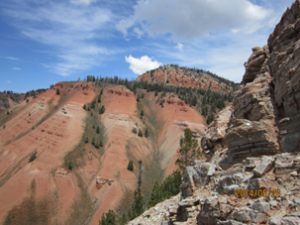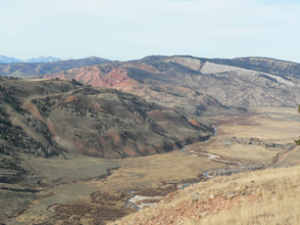Gros Vente Field Trip - July 2017
Geologists of Jackson Hole had a great field trip up the Gros Ventre valley. We drove to a campsite above the Crystal Creek campground for a 2 night stay. The second night chef Steve Weichman prepared the main course and we each brought side dishes. There was a hike on Saturday into the Mesozoic sediments shown in the attached photo. There are bathroom facilities close by in the Crystal Creek campground. This is approximately a 1 hour drive from Jackson and carpooling is encouraged.
The Gros Ventre Mountains are the western edge of the Laramide Orogeny which lifted large fault blocks up as the continental crust was compressed across the entire width of what is today Wyoming, approximately 65-50 million years ago. However more recently the continental crust in what is today the extreme western edge of Wyoming has experienced extension, which has caused the western extension of the Gros Ventre Mountains (they extended into what is today easternmost ID ~4 mya) to rotate (subside) into a half-graben formed by the Teton fault. This has conveniently led to the formation of westward flowing river which will give us easy access to the mountains. We will enter the valley by first driving over a moraine left by the Pinedale ice sheet. This ice sheet at one time blocked the valley but the river has now cut through the moraine.
The drive up the valley reminds one constantly that the mountains are not permanent but instead are ever eroding sometimes in dramatic landslides and other times in unpretentious slumps. Past the Gros Ventre slide are the Red Hills, the remains of Triassic passive continental margin. The red is oxidized iron but occasionally one sees green rocks where carbon has chemically reduced the iron. There is a thick layer of gypsum visible in the Red Hills formed from the evaporation of a large inland sea which left salt deposits further to the east. Examples of these rocks and more will be at the campsite where will see some simple chemical demonstrations that give insight into the rocks. The Red Hills are capped by the Nugget Sandstone, the remains of a Saharan type desert. We will take a hike up through the Red Hills to see these layers up close. The hill looks steep but the sediment is soft and easy to walk in. We are likely to see some ripple marks and fossils from that ancient sea.
dramatic landslides and other times in unpretentious slumps. Past the Gros Ventre slide are the Red Hills, the remains of Triassic passive continental margin. The red is oxidized iron but occasionally one sees green rocks where carbon has chemically reduced the iron. There is a thick layer of gypsum visible in the Red Hills formed from the evaporation of a large inland sea which left salt deposits further to the east. Examples of these rocks and more will be at the campsite where will see some simple chemical demonstrations that give insight into the rocks. The Red Hills are capped by the Nugget Sandstone, the remains of a Saharan type desert. We will take a hike up through the Red Hills to see these layers up close. The hill looks steep but the sediment is soft and easy to walk in. We are likely to see some ripple marks and fossils from that ancient sea.
Itinerary:
Friday July 7th – drive up the Gros Ventre road to the campsite. People may follow their own schedule. I will depart Jackson at 3pm. I will stop at the lower slide, Atherton campground and the Red Hills as we benefit from David Love’s road log. Digital copies of the road log will be provided.
Saturday July 8th – at 10am we will carpool and hike up the Red Hills. When we return we will do some chemistry. Steve will prepare the evening meal.
Sunday July 9th – we will drive back making stops again at Atherton campground and the lower slide. Return to Jackson by 5.
Materials Slide Show
